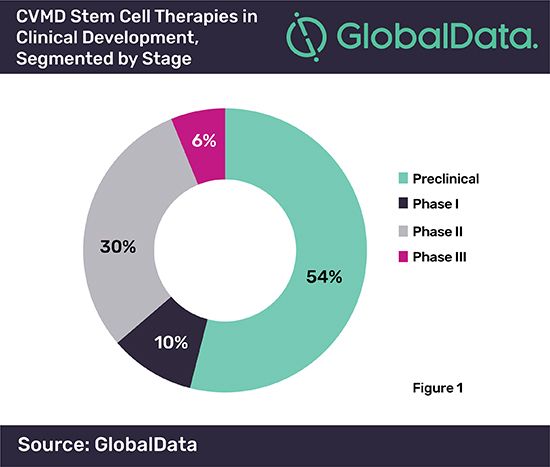Regenerative Medicine Could "Displace Current Treatments in CVMD Space within Next Decade"
Regenerative medicine could potentially displace standard of care treatments used for chronic diseases such as heart failure or diabetes within the next decade, according to data and analytics company GlobalData. Currently, small bio-techs are leading R&D efforts on a variety of cardiovascular (CV) stem cell therapies, while big pharma drives metabolic disorder (MD) stem cell therapy research, with AstraZeneca, Johnson & Johnson, Novo Nordisk and Sanofi gearing up to develop novel treatments for diabetes. Within the entire cardiovascular and metabolic disorder (CVMD) space, the current stem cell pipeline features approximately 116 candidates. However, the majority (54%) of the pipeline candidates are in preclinical development, with only 6% of candidates being evaluated in Phase III clinical trials.

Of all the CVMD stem cell pipeline therapies, 73% target CV indications and 27% target metabolic indications. Within the CV stem cell therapies, a disproportionately large number of them target heart disease indications, such as heart failure, cardiomyopathy, left ventricular dysfunction and myocardial infarction.

Regenerative therapies targeting cardiovascular indications aim to demonstrate that stem cells introduced into the body can induce the formation of new capillaries or/and improve function of impaired or injured heart tissue. Prominent mid- to late-stage CV stem cell pipeline candidates such as Mesoblast’s Revascor, Celixir’s Heartcel, and Capricor’s CAP-1002, target heart failure, a chronic disease with a slew of unmet needs. Key opinion leaders (KOLs) interviewed by GlobalData indicated that they are eager to have these novel treatments at their disposal, especially for patients with advanced heart failure and unable to receive a heart transplant, patients with non-ischemic cardiomyopathy, and heart failure patients with preserved ejection fraction. GlobalData analyst Jesus Cuaron, Ph.D., P.P.M., commented: “Despite big pharma investment in MD stem cell therapies, the majority of the candidates are still in early R&D stages, whereas several CV stem cell therapies are already in Phase II or Phase III clinical trials. It is therefore highly probable that marketed “off-the-shelf” CV stem cell therapies will become available within the next decade.”
Addressing Disparities in Psoriasis Trials: Takeda's Strategies for Inclusivity in Clinical Research
April 14th 2025LaShell Robinson, Head of Global Feasibility and Trial Equity at Takeda, speaks about the company's strategies to engage patients in underrepresented populations in its phase III psoriasis trials.
Beyond the Prescription: Pharma's Role in Digital Health Conversations
April 1st 2025Join us for an insightful conversation with Jennifer Harakal, Head of Regulatory Affairs at Canopy Life Sciences, as we unpack the evolving intersection of social media and healthcare decisions. Discover how pharmaceutical companies can navigate regulatory challenges while meaningfully engaging with consumers in digital spaces. Jennifer shares expert strategies for responsible marketing, working with influencers, and creating educational content that bridges the gap between patients and healthcare providers. A must-listen for pharma marketers looking to build trust and compliance in today's social media landscape.
Pfizer, GSK Gain ACIP Recommendations for RSV and Meningococcal Vaccines
April 18th 2025The Centers for Disease Control and Prevention’s Advisory Committee on Immunization Practices voted to expand access to Pfizer’s respiratory syncytial virus vaccine Abrysvo for high-risk adults in their 50s and voted in favor of GSK’s meningococcal vaccine, Penmenvy, for streamlined adolescent protection.